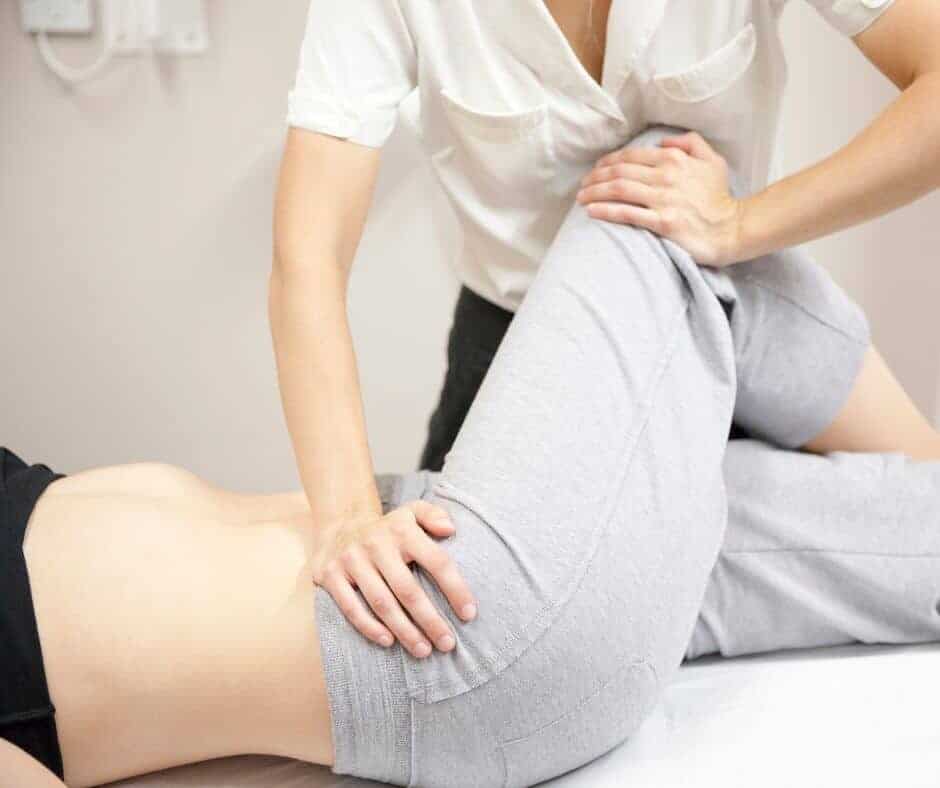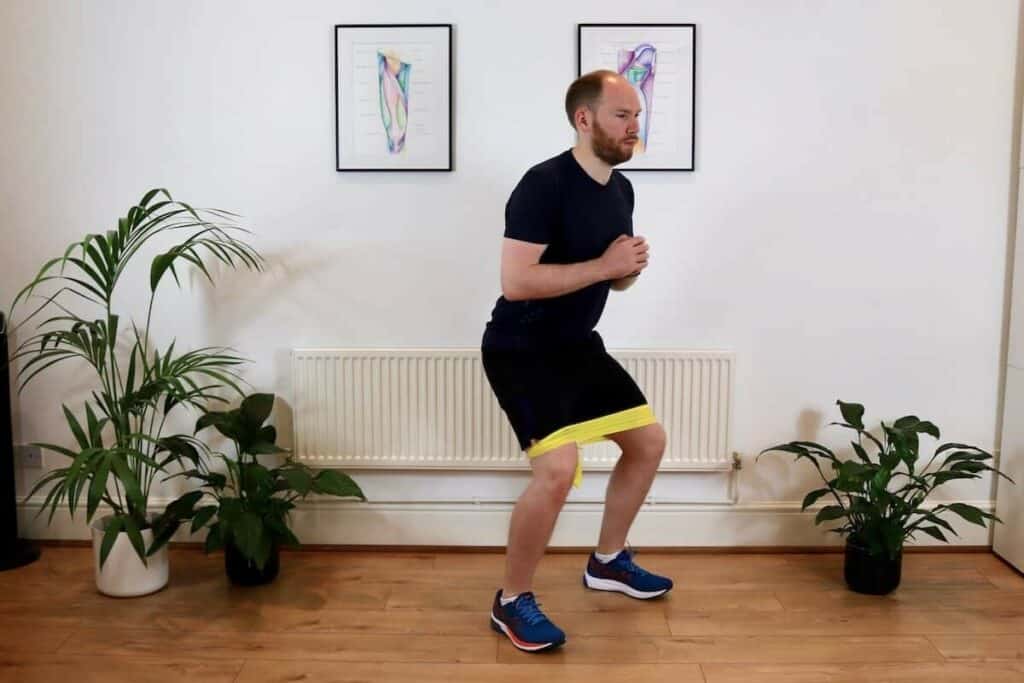Hip Bursitis: Symptoms, Causes & Exercises
- Best Asics Shoes for Flat Feet - October 25, 2024
- Best Running Shoes for Flat Feet - October 22, 2024
- Posterior Tibial Tendonitis - October 21, 2024
What Is Bursitis Of The Hip?
Bursitis is the inflammation of these bursae caused by excessive friction, compression or infection. The most common hip bursitis is that of the greater trochanteric bursa. A bursa is a fluid-filled sack, a bit like a balloon, and there are over 150 of these in our bodies.
The bursa acts like a sliding sheet by offering a smooth cushion that can glide as the body moves. Bursae are located over points of potential friction to prevent injury. There are several bursae at the hip, the most important being the greater trochanteric bursa, iliopsoas bursa and ischiogluteal bursa.
Symptoms
So, what does bursitis in the hip feel like? Most patients will describe symptoms as an ache on the side of their hip. If the affected bursa is the greater trochanteric bursa, the most common bursa will get inflamed.
The pain can also be sharp if it is aggravated or in specific positions that cause aggravation by pinching or compressing it.
Pain Location
The location of pain with hip bursitis will depend on the inflamed bursa.
Greater trochanteric bursitis will be painful on the lateral side of the hip. That is because the bursa is located at the side of the hip between the greater trochanter of the femur and the gluteus maximus muscles.
The iliopsoas bursa is between the iliopsoas musculotendinous junction and the capsule of the hip joint, and pain will be felt at the front of the hip.
The ischiogluteal bursa is between the ischial tuberosity of the pelvis and the gluteus maximus muscle; pain will be felt on and around the seat bone.
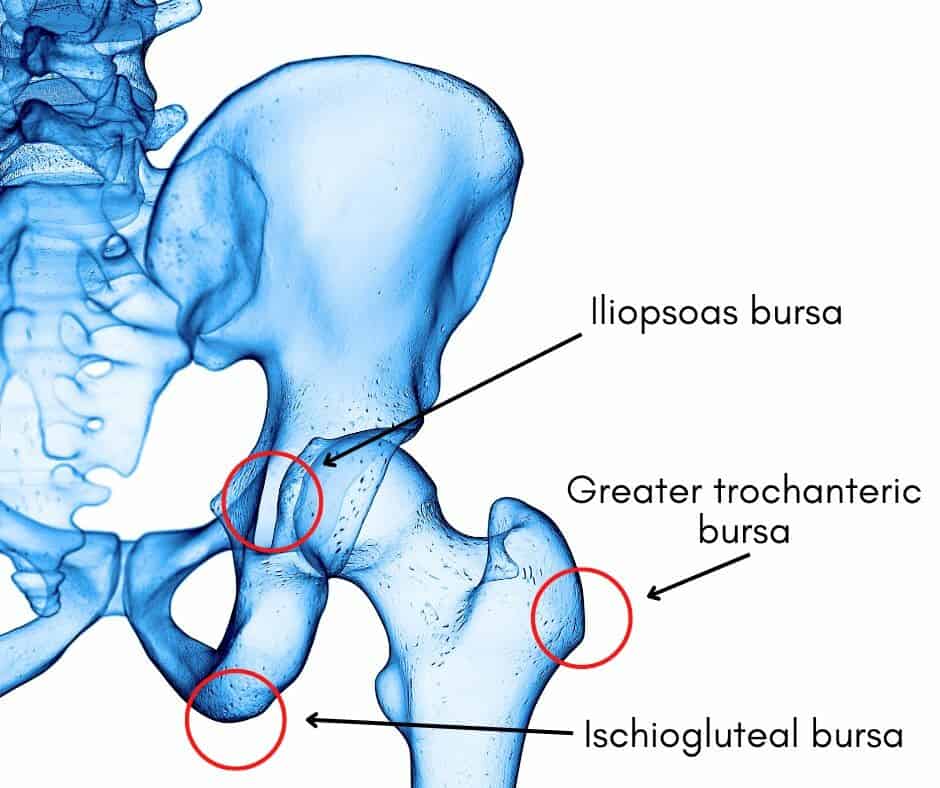
Causes?
Hip bursitis is most commonly caused over a period of time by chronic excessive force, compression or friction of the bursa. Repetitive movements or postures are the most common causes of bursitis and biomechanical factors can increase the risk of developing this injury.
For example, weakness of the muscles around the hip and pelvis can increase the risk of greater trochanteric bursitis. This weakness can cause greater adduction of the hip joint with actions such as walking and running, which can put more pressure on the bursa. Combine this with increased walking or running, and greater trochanteric bursitis may develop.
Trauma can also cause bursitis. A sudden high-pressure overload, such as a fall onto the bursa, can cause acute inflammation. Falling on the outside of the hip or the seat bone can cause greater trochanteric bursitis and ischiogluteal bursitis, respectively.
The final cause of bursitis is infection. This is most common with bursae that sit just below the skin, as a break in the skin can introduce bacteria to the bursa. Busae of the knee and elbow are more likely to develop infectious bursitis than around the hip. However, a deeper wound or a systemic infection can cause infections of bursitis at the hip.
Diagnosis
As with most musculoskeletal injuries, there is no conclusive hip bursitis test. It is diagnosed through a series of assessments during a medical examination.
Clinical Tests
Indicators that the diagnosis is hip bursitis are the location of pain and pain reproduced with pressure over the specific bursa, with activation of the muscles over the bursa and different postures or positions that compress the bursa.
30-second Single Leg Stand Test for Hip Bursitis: The person being tested must stand, unassisted, on one leg with their eyes open and one finger on a wall. As soon as the person’s foot is lifted off the floor, the 30 seconds start. A positive test for patients with GTPS is lateral hip by 30 seconds. Grimaldi and Fearon (2015) suggest holding the position until the reproduction of symptoms.
Imaging
Further confirmation of a diagnosis can be through diagnostic imaging: x-ray, MRI and ultrasound. Of these, MRI and ultrasound are the most accurate.
An MRI can provide a clear image of a cross-section through the body, so the specific hip bursa that is affected can be identified, and the size can be easily measured. However, MRI is expensive and takes a still image in one position.
The benefit of ultrasound is that it is cost-effective and performed dynamically. This is beneficial when the bursitis is mild and may only be seen in specific positions of compression.
Treatment
Home Remedies
The best home remedies for hip bursitis are using ice or heat for pain relief and avoiding painful activities. Both heat and ice can provide pain relief, and neither will affect long-term recovery, so you can use whichever gives you the best relief. There is usually an accurate relationship between pain and aggravation of the bursa, so pain should be avoided and not ignored.
Home exercises such as stretches and strengthening the muscles around the hip can be very effective, even more so if guided by a physical therapist. If they have prescribed them specifically for you after a thorough assessment. Additionally, tape can be used at home once you have been shown how to apply it.
Physical Therapy
Physical therapy exercises for hip bursitis are the best way to manage and treat most cases of hip bursitis. Physical therapy exercises are prescribed to you after a physical examination so that the appropriate exercises are set at an appropriate level for your injury and your body and at the specific phase of recovery you have reached.
KT Tape
Additional treatments, such as taping, can sometimes help with pain relief. KT tape is an elasticated tape that can be applied directly to the skin around the painful area. It can work in many ways depending on where and how it is applied.
It reduces pain by increasing your awareness of the area and tightening if you move into a position that might aggravate the bursa. Some brands suggest it can lift the upper layers of tissue to improve blood circulation, which may provide some pain relief, though there is mixed evidence to support this.
Best Exercises for Hip Bursitis
Trochanteric Bursitis Exercises PDF
Download all of our recommended exercises for hip bursitis in an easy-to-use PDF.
The following exercises are common choices for treating hip bursitis. They focus on strengthening the thigh’s gluteal, quadriceps, and hamstring muscles. Careful attention should be made to avoid positions where the legs are too close together, as this can put compressive forces on the bursa, which can aggravate pain.
Exercises with the band are a great way of keeping the legs apart while also working the lateral gluteal muscles. Exercises must be appropriate for you, so it is best to check with your physical therapist if these are the best exercises to do in your recovery.
Bridge with a Band
Start lying on your back with your feet hip-width apart and your knees about 90º bent. Tie the resistance band tight enough around your thighs so that you have some resistance to push outwards into when you are in this position.
Tilt your pelvis backwards, flattening your back into the floor and curl your pelvis and back off the floor as you raise your hips up. Slowly lower to return to the start position.
Repeat 8-12 times, rest and repeat for 3 sets.
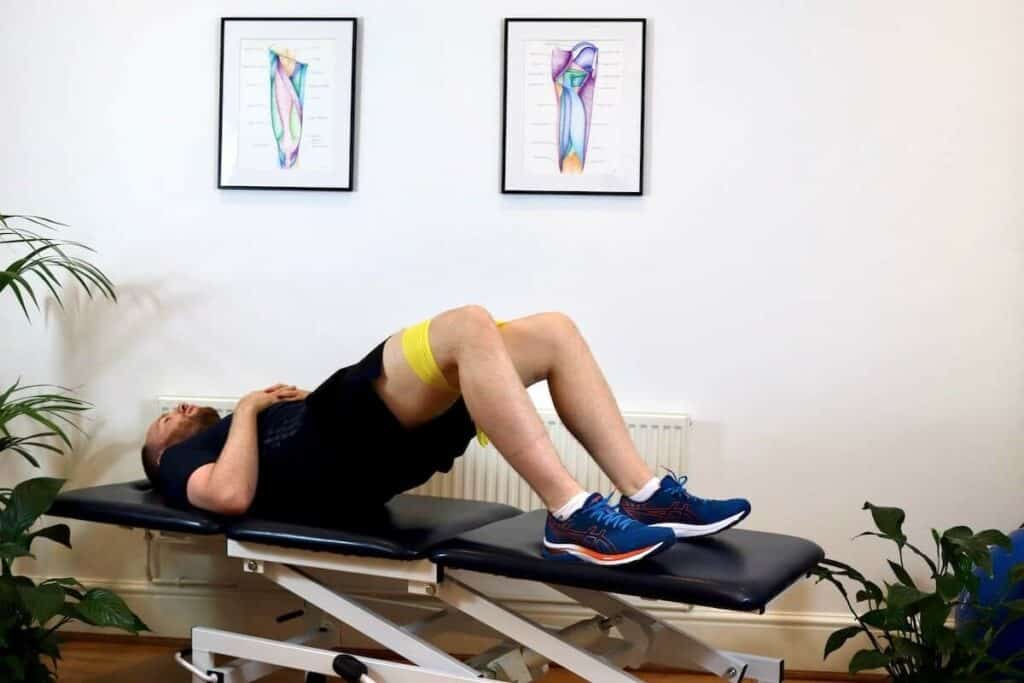
Hip Abduction with a band
Lie on your side with a resistance band tied around your ankles. You may want to put a pillow between your legs to rest your top leg between sets while keeping a gap between your legs. Make sure your body is slightly rolled forward so that your buttocks are uppermost.
Slowly lift your top leg from hip height, moving up and backwards diagonally. Slowly return to hip height and repeat.
Repeat 8-12 times, rest and repeat for 3 sets.
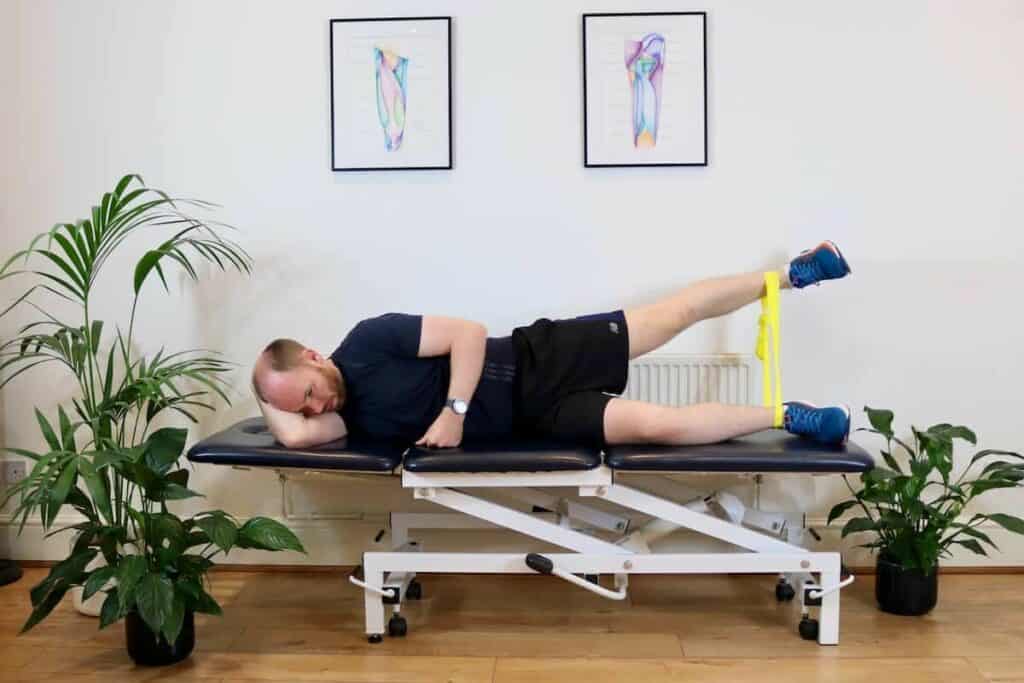
Squat with a Band
Start with your feet hip-width apart and tie the resistance band tight enough around your thighs so that you have some resistance to push outwards into when you are in this position.
Slowly lower your pelvis back and down as though to sit in a chair. Slowly return up by squeezing your buttocks and pushing your pelvis forward.
Repeat 8-12 times, rest and repeat for 3 sets.
Hip Bursitis Stretches
In the initial acute phase, hip bursitis can be very painful, and stretches can worsen the pain, particularly stretches of the glutes that compress the bursa.
Therefore, these stretches are often better in the later stages of rehab. You should only do these stretches if they are not painful, and only continue doing them if you feel better after and no additional pain in the following hours.
Glute Stretch
Lie on your back and cross your ankle over the opposite thigh. Pull your thigh towards your chest, and you should feel a stretch across your buttocks.
Hold this position for 45 seconds, and repeat every 2-3 hours.
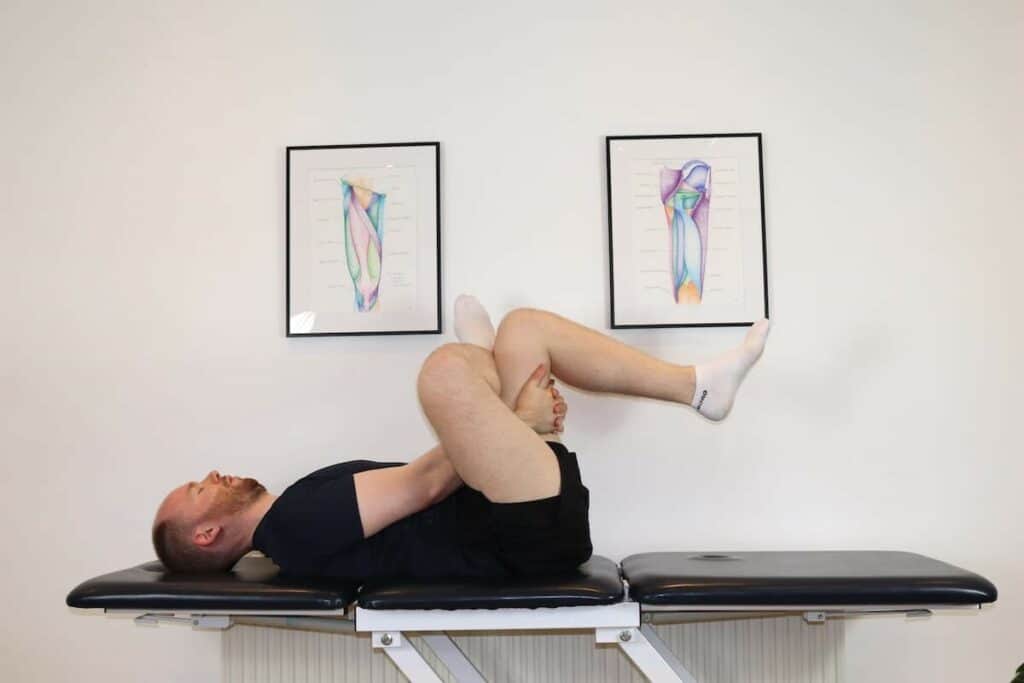
Hip Flexor Stretch
Kneel on the floor with one knee and step the other leg through. Make your body tall, keep your back straight, and avoid arching your lower back. Shift your weight forward to feel a stretch and the front of your hip of your kneeling leg.
Hold this position for 45 seconds, and repeat every 2-3 hours.
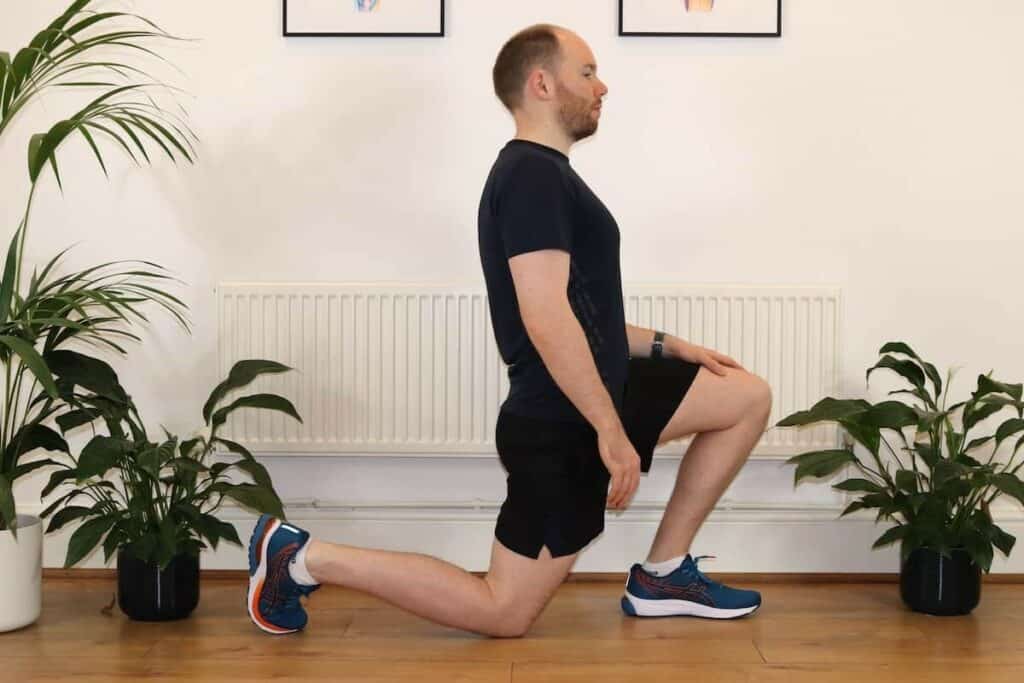
Hip Bursitis Surgery
Surgery for hip bursitis is rarely necessary and should always be considered a last resort. It should only be considered if all other treatment options have been exhausted, including an appropriately long period of effective physical therapy, activity modification, medications, injections and assisted devices such as braces.
Surgery to resolve hip bursa pain from greater trochanteric bursitis typically involves bursectomy, the removal of the bursa, and/or iliotibial band release. Most of the time, surgery can be performed arthroscopically.
Recovery from surgery is relatively quick, usually taking no more than 6 weeks. Most people will need crutches, at most, for a couple of days while the initial soreness subsides. Following the surgery, rehabilitation with a physical therapist is strongly advised.
A therapist will be able to guide you through the recovery process to get you back to the activities you love. for higher-impact activities such as running and other sports, you may be advised to wait longer than 6 weeks. This will depend on your specific case, type of surgery, pain levels, strength and fitness.
Recovery Time
Recovery from hip bursitis will vary between individuals, but in our experience, most cases can resolve over 4-6 weeks. This is for cases that have developed suddenly from trauma, such as a fall onto the hip, in an otherwise healthy and strong individual, and they follow the appropriate rest and exercises for recovery. Or cases that have sought advice and treatment very early after the onset of symptoms.
However, it is more commonly a chronic condition that gradually develops over a prolonged period, even if the pain has started suddenly. It may be that the bursa has been stressed for a long time, and the muscles may be weak. In these cases, recovering fully may take 3-4 months. It can take longer if symptoms have been ignored for a long time, or appropriate treatment and rest have not been followed.
Further Reading
Exercises to Avoid for Hip Bursitis – Braces and Supports for Hip Bursitis – Proximal Hamstring Tendinopathy
_______________________________________
We are specialists in Physiotherapy, with our clinic in Fulham, South West London.
We offer Online Appointments for £60 and Face-to-Face appointments for £85 in our clinics.

